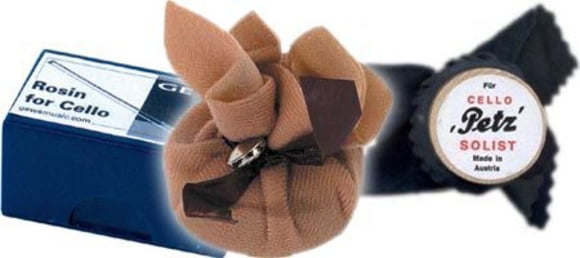9. Accessories
Strings
Most instrument shops stock a considerable range of strings. The finest are still made of natural gut, usually wound with aluminium or silver to create a smooth, durable finish these are known as covered gut strings. While these strings ultimately produce the best and warmest sound, there are also a large number of covered strings available made with a synthetic core in place of the gut. Over the years, their quality has improved dramatically, and for many applications (and certainly for the beginner) they are almost the equal of their natural counterparts. In addition, they have two advantages over gut strings they tend to last a little longer, and also settle down more quickly when newly fitted, both in terms of tuning and the sound they produce.
Fitting strings is something that should initially be done by a professional, observed by the student in order to learn how it is done. Once you have progressed to doing this at home, never forget that strings are each specific to the pitch they are tuned to (A, D, G, C - the A being the highest in pitch and the C the lowest) and are not interchangeable, so dont get them mixed up! Similarly, each string leads to a specific peg, so its best to change strings one at a time to avoid confusion.
Rosin
Essentially a refined form of the resin produced by coniferous trees, rosin helps the hair of the bow to draw an even sound out of the string by increasing the friction between the two. There are dozens of different makes of varying quality and price, but most come as brittle blocks wrapped in cloth or card packaging. The colour varies from amber to almost black and it is the darker coloured versions, being softer and therefore stickier, that tend to be better suited to cellos and basses. Its best to handle rosin by the packaging rather than touching the block itself, as its stickiness is by nature rather resistant to washing off with soap and water. In terms of how much to apply, this is a case of less is more if after playing, the belly of the instrument and the stick of the bow resemble a snowy waste, then clearly far too much is being used!
Adjusters
Adjusters are small metal fine tuners that are fixed to the tailpiece, one per string to make the job of tuning the instrument rather easier. Some cellists prefer to replace the traditional wooden tailpiece with an integrated metal or plastic one that has all four adjusters built in.
Wolf Note Eliminators
Wolf notes are almost inevitable on cellos and occur when the vibrations of the strings and the vibrations of the instrument on a specific note, or notes, interact with each other to produce a strange buzzing, or howling sound, usually on one of the lower strings. There is a commonly held belief that the finer the cello, the more likely it is to have pronounced wolf notes, so if your instrument suffers from them, consider it a badge of honour, rather than a source of embarrassment - in the unlikely event that your cello has no wolf notes at all, perhaps its time to upgrade! In any case, the most common solution is to fit a wolf note eliminator, a small brass and rubber tube that fits on the relevant string between the bridge and the tailpiece.
Spike Holders
There are an enormous variety of products on the market - all designed to stop the spike slipping and to stop it damaging floors. They range from simple rubber tips that fit over the point, to much more elaborate pieces of equipment which attach to the chair legs, plus a host of other designs falling somewhere in between. Most cellists will swear by a particular type, but finding which one suits you is largely a matter of trial and error.







